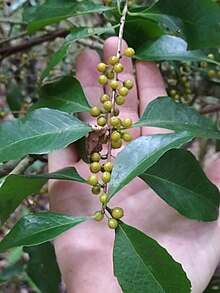Denhamia fasciculiflora, commonly known as orange bark, is a plant in the family Celastraceae found only in Queensland, Australia.
| Orange bark | |
|---|---|

| |
| Immature fruit | |
| Scientific classification | |
| Kingdom: | Plantae |
| Clade: | Tracheophytes |
| Clade: | Angiosperms |
| Clade: | Eudicots |
| Clade: | Rosids |
| Order: | Celastrales |
| Family: | Celastraceae |
| Genus: | Denhamia |
| Species: | D. fasciculiflora
|
| Binomial name | |
| Denhamia fasciculiflora | |
| Synonyms[1][2] | |
| |
Description
editIt is a shrub or small tree up to 8 m (26 ft) tall. The leaves are broadly elliptic and often arranged in pseudowhorls. They measure up to 10 cm (3.9 in) long and 5 cm (2.0 in) wide and have bluntly toothed edges. Flowers arise from the twigs or leaf axils in short fascicles, and are very small with four or five 2 mm (0.08 in) long petals. The fruit is an almost spherical capsule about 7 mm (0.28 in) diameter, containing one or two aril-covered seeds.[4][5]
Taxonomy
editThe plant was first described in 1984 by Australian botanist Laurence W. Jessup as Maytenus fasciculiflora, and published in an appendix to volume 22 of the book series Flora of Australia.[6] In 2011, American botanist Mark P. Simmons published a paper in which the Australian species of Maytenus were transferred to Denhamia, giving this plant its current binomial name.[7]
Distribution and habitat
editThe species is found in northeastern Queensland, from Cape York Peninsula to the Atherton Tablelands.[4][5]
Conservation
editAs of November 2024[update], this species has been assessed to be of least concern by the International Union for Conservation of Nature (IUCN) and by the Queensland Government under its Nature Conservation Act.[3][8]
References
edit- ^ a b "Denhamia fasciculiflora". Australian Plant Name Index (APNI). Centre for Australian National Biodiversity Research, Australian Government. Retrieved 25 November 2024.
- ^ a b "Denhamia fasciculiflora (Jessup) M.P.Simmons". Plants of the World Online. Royal Botanic Gardens, Kew. 2024. Retrieved 25 November 2024.
- ^ a b IUCN SSC Global Tree Specialist Group & Botanic Gardens Conservation International (BGCI). (2021). "Denhamia fasciculiflora". IUCN Red List of Threatened Species. 2021: e.T192496805A192496807. doi:10.2305/IUCN.UK.2021-1.RLTS.T192496805A192496807.en. Retrieved 25 November 2024.
- ^ a b Jessup, L.W. (2022). Kodela, P.G. (ed.). "Denhamia fasciculiflora". Flora of Australia. Australian Biological Resources Study, Department of Climate Change, Energy, the Environment and Water: Canberra. Retrieved 25 November 2024.
- ^ a b F.A.Zich; B.P.M.Hyland; T.Whiffen; R.A.Kerrigan (2020). "Denhamia fasciculiflora". Australian Tropical Rainforest Plants Edition 8 (RFK8). Centre for Australian National Biodiversity Research (CANBR), Australian Government. Retrieved 25 November 2024.
- ^ Jessup, L.W. (1984). "Appendix". In George, A.S. (ed.). Flora of Australia (PDF). Vol. 22: Rhizophorales to Celastrales. Canberra: Australian Government Publishing Service. p. 223. ISBN 0 644 02862 9.
- ^ McKenna, M.J.; Simmons, M.P.; Bacon, C.D.; Lombardi, J.A. (2011). "Delimitation of the Segregate Genera of Maytenus s. l. (Celastraceae) Based on Morphological and Molecular Characters". Systematic Botany. 36 (4): 922–932. doi:10.1600/036364411X604930.
- ^ "Species profile—Denhamia fasciculiflora". Queensland Department of Environment and Science. Queensland Government. 2024. Retrieved 25 November 2024.
External links
edit- View a map of herbarium collections of this species at the Australasian Virtual Herbarium
- View observations of this species on iNaturalist
- View images of this species on Flickriver.com